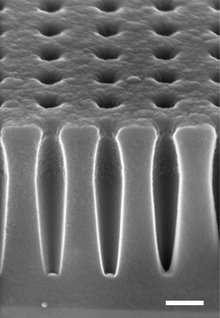Nanohole

Nanoholes are a class of nanostructured material consisting of nanoscale voids in a surface of a material. Not to be confused with nanofoam or nanoporous materials which support a network of voids permeating throughout the material (often in a disordered state), nanohole materials feature a regular hole pattern extending through a single surface. These can be thought of as the inverse of a nanopillar or nanowire structure.
Uses
Nanohole structures have been used for a variety of applications, ranging from superlenses produced from a metal nanohole array,[1] to structured photovoltaic devices used to improve carrier extraction,[2] and light absorption.[3]
Nanohole structures are also extensively utilized for the creation of photonic crystals, particularly for creating photonic crystal waveguides.
See also
References
- ↑ Huang, Fu Min; Kao, Tsung Sheng; Fedotov, Vassili A.; Chen, Yifang; Zheludev, Nikolay I. (2008). "Nanohole Array as a Lens". Nano Letters. 8 (8): 2469–2472. doi:10.1021/nl801476v. ISSN 1530-6984.
- ↑ Johlin, Eric; Al-Obeidi, Ahmed; Nogay, Gizem; Stuckelberger, Michael; Buonassisi, Tonio; Grossman, Jeffrey C. (2016). "Nanohole Structuring for Improved Performance of Hydrogenated Amorphous Silicon Photovoltaics". ACS Applied Materials & Interfaces. 8 (24): 15169–15176. doi:10.1021/acsami.6b00033. ISSN 1944-8244.
- ↑ Peng, Kui-Qing; Wang, Xin; Li, Li; Wu, Xiao-Ling; Lee, Shuit-Tong (2010). "High-Performance Silicon Nanohole Solar Cells". Journal of the American Chemical Society. 132 (20): 6872–6873. doi:10.1021/ja910082y. ISSN 0002-7863.